Popular herbal heart notes add essential depth and character to your perfumes. You'll commonly find lavender for its calming properties, rosemary for its invigorating freshness, and clary sage for its sweet, herbaceous balance. These middle notes work beautifully with citrus top notes and woody base notes, creating complex fragrances that last. Natural options like thyme and sweet marjoram offer therapeutic benefits beyond just fragrance. Understanding these herbal notes opens up endless possibilities for creating stunning perfume combinations.
Understanding Herbal Heart Notes in Modern Perfumery

As perfumery continues to evolve, herbal heart notes have become essential building blocks in modern fragrance composition. You'll find these versatile notes playing an important role in balancing complex fragrances while adding depth and character to various perfume families.
When you explore modern perfumes, you'll discover popular herbal heart notes like lavender, rosemary, and thyme creating fresh, invigorating experiences. These notes don't just smell good – they're carefully selected to evoke emotional responses and provide stability between top and base notes. The emotional impact of these herbal notes can shape cognitive function through their distinctive aromatic profiles.
Through steam distillation and natural extraction methods, perfumers capture the authentic essence of these herbs. You'll notice how they're often paired with florals, spices, or woody notes to create unique accords.
Modern perfumers are experimenting with these traditional ingredients while incorporating contemporary techniques to craft timeless yet innovative fragrances.
Essential Herbal Notes and Their Distinctive Properties
You'll find powerful aromatherapy benefits in lavender's soothing qualities, making it a go-to choice for calming perfume compositions.
The craft of aromatherapy has evolved from ancient civilizations' rituals, where herbs were prized for their therapeutic properties and divine connections.
Rosemary brings an invigorating green freshness that can energize your senses while adding natural depth to fragrance blends.
Clary sage rounds out these essential herbal heart notes with its perfectly balanced sweet and herbaceous character, creating harmony in complex perfume formulations.
Lavender's Calming Healing Powers
While many natural ingredients offer therapeutic benefits, lavender stands out as one of perfumery's most versatile and healing herbal notes. You'll find this powerful essential oil working double duty in your favorite fragrances – not only creating a beautiful scent but also delivering remarkable therapeutic properties.
When you're wearing a lavender-based perfume, you're benefiting from its natural ability to reduce stress, promote relaxation, and even help with sleep issues. True lavender essential oil, known as Lavandula Angustifolia, is particularly valued for its potent sedative effects. It's also an exceptional antimicrobial and anti-inflammatory agent, making it particularly beneficial for those with sensitive skin.
As a heart note in perfumery, lavender's calming properties blend seamlessly with both fresh top notes and deep base notes, while its healing powers continue working throughout the day, soothing your mind and protecting your skin.
Rosemary's Fresh Green Profile
Three key elements define rosemary's distinctive profile in perfumery: its vibrant herbaceous freshness, its resinous undertones, and its remarkable versatility as a heart note.
You'll find rosemary's complexity comes from its Mediterranean heritage, where it thrives in sun-drenched, rocky soils. When perfumers extract its essence through steam distillation, they capture a dynamic aroma that combines pine-like sharpness with earthy warmth.
In fragrance design, you'll notice how rosemary brightens top notes while providing structural support through its woody character.
It's particularly effective when paired with citrus notes like bergamot and lemon, or when balancing heavier woods like cedarwood.
You can experience this versatility in classics like Dior Eau Sauvage and Acqua di Parma Colonia, where rosemary adds depth and freshness to their compositions.
Clary Sage's Sweet Balance
Beyond its traditional medicinal uses, clary sage brings a fascinating complexity to perfumery with its sweet, herbaceous character and multifaceted aromatic profile.
You'll discover an intriguing blend of earthy, musky notes balanced with fresh, green spices that create both warmth and freshness in your compositions.
As a middle note, clary sage's versatility shines when you pair it with other botanicals. It works beautifully with citrus, lavender, and woody scents, while also harmonizing with florals like jasmine, rose, and geranium.
You'll appreciate how this Mediterranean herb enhances your creative blending process, thanks to its unique ability to bridge different fragrance families.
Originally cultivated for its therapeutic properties, clary sage continues to offer both aromatic appeal and calming benefits in modern perfumery.
Blending Techniques for Herbal Middle Notes
Since herbal middle notes form the heart of any perfume blend, mastering their combination techniques is essential for creating balanced fragrances.
You'll want to allocate 50-75% of your blend to middle notes, using common options like lavender, rose, or sweet marjoram.
When blending, start with the drop-by-drop method. Add your base notes first, followed by middle notes, and finish with top notes.
You can follow ratios like 1:1:1 or 3:2:1 (top:middle:base) as a starting point. For therapeutic blends, use 2-10 drops of middle notes per ounce of carrier oil.
Remember that middle notes create harmony between top and base notes while adding complexity to your blend. They contain calming compounds like linalool and help mask any unpleasant odors from base notes.
Classic Herbal Heart Note Combinations
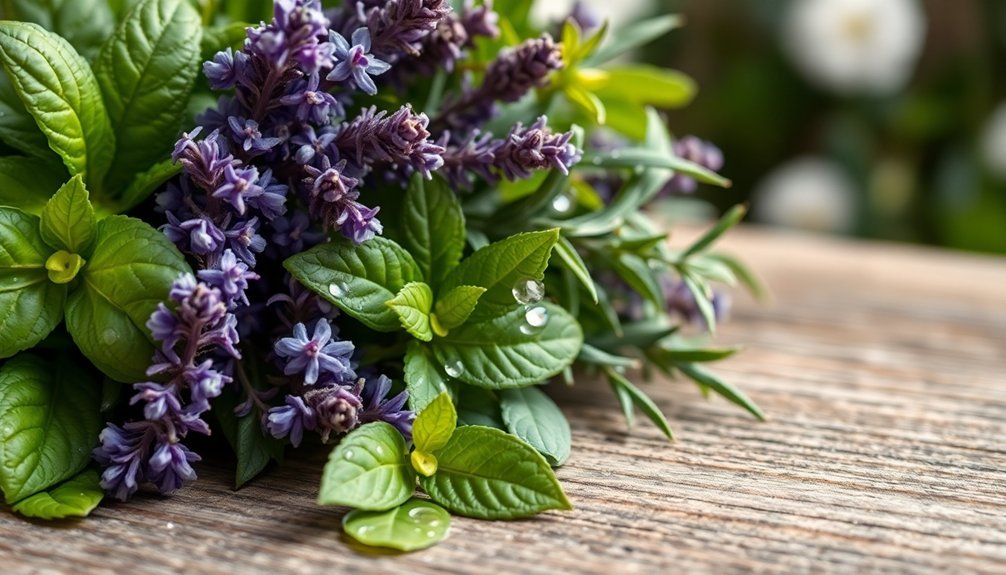
When you're ready to explore classic herbal heart note combinations, start with timeless pairings like lavender and rose for their perfect balance of floral sweetness and herbal freshness.
You'll find that bright citrus notes complement fresh herbs beautifully, creating vibrant and uplifting compositions that shine in summer fragrances.
For a more grounded scent profile, try combining woody base notes with herbal hearts like rosemary or thyme to achieve remarkable depth and lasting character.
Lavender Meets Rose Beauty
As two of perfumery's most beloved heart notes, lavender and rose create a harmonious blend that combines herbal freshness with romantic floral undertones. This classic pairing offers you both calming and uplifting properties, making it ideal for personal fragrances and home aromatics.
You'll find this combination especially effective in perfume oils, where the scent lasts longer than alcohol-based alternatives. The blend often features pure essential oils and absolutes in organic bases like jojoba or coconut oil, making it gentle on sensitive skin while providing moisturizing benefits.
When you're applying the fragrance, focus on pulse points for best scent release, or mist it lightly on your hair and clothing. You can wear it alone or layer it with other scents to create your unique signature fragrance.
Fresh Herbs With Citrus
Building on the romantic charm of lavender and rose, fresh herbs paired with citrus notes create an equally enchanting but distinctly vibrant heart note combination. You'll find that bergamot's complex profile harmonizes beautifully with lemongrass, while lemon perfectly complements basil's aromatic intensity. Grapefruit and rosemary create an invigorating blend that's both invigorating and sophisticated.
| Citrus Note | Herb Pairing | Effect |
|---|---|---|
| Bergamot | Lemongrass | Nuanced & Complex |
| Lemon | Basil | Fresh & Aromatic |
| Grapefruit | Rosemary | Bright & Balanced |
These combinations work exceptionally well in the heart of your fragrance, creating a seamless shift between top and base notes while adding depth and character to your perfume's core structure.
Woody-Herbal Perfect Pairings
The timeless marriage of woody and herbal notes creates some of perfumery's most sophisticated heart combinations.
You'll find these pairings in four distinct categories that offer unique aromatic experiences.
For fresh and green elements, you can't go wrong with lavender or geranium combined with woody bases. They provide a crisp, natural dimension.
If you're seeking warmth, spicy notes like cardamom and cinnamon blend beautifully with cedarwood and sandalwood.
For a more romantic approach, try Damask rose or jasmine with woody notes – they create an elegant, balanced composition.
The earthiest combinations include patchouli with cedarwood or oud, while sage paired with cedarwood delivers a grounded, aromatic profile.
These woody-herbal duos have stood the test of time for their remarkable ability to complement each other.
The Art of Balancing Herbal Notes With Other Accords
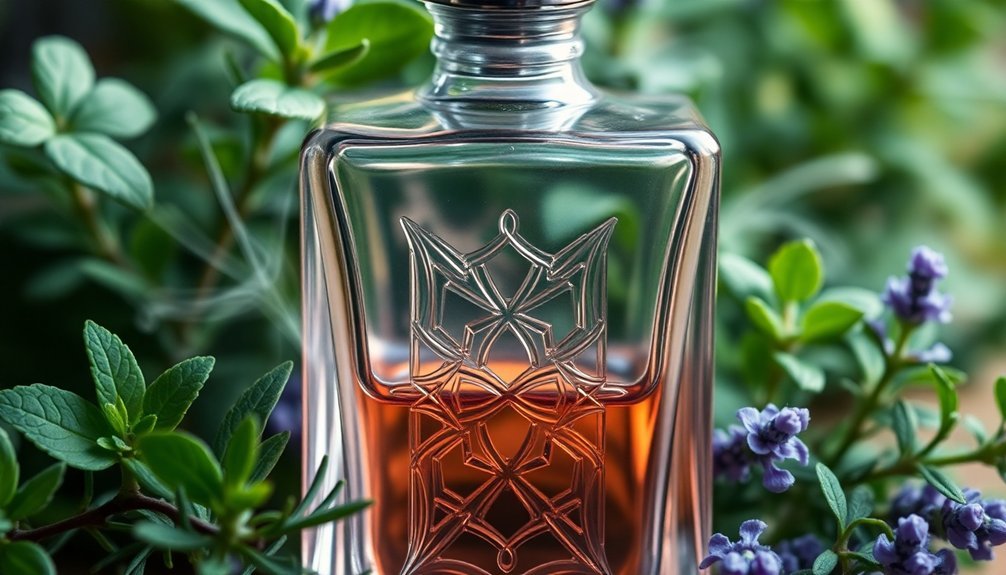
Creating a harmonious perfume requires masterful blending of herbal heart notes with complementary accords. You'll find that rosemary pairs beautifully with floral notes like jasmine and rose, while basil can add a fresh herbaceous layer to enhance the overall floral profile.
When you're working with spicy accords, try combining basil with cinnamon and vanilla, or rosemary with nutmeg and cardamom for added depth.
For woody combinations, you can match rosemary with cedarwood or sandalwood to create a sophisticated grounding effect.
Don't hesitate to experiment with layering – herbal heart notes work wonderfully with citrus top notes or gourmand accords like vanilla and amber. The key is finding the right balance that allows each note to shine while creating a seamless shift between top and base notes.
Natural Vs Synthetic Herbal Heart Notes
Understanding the distinction between natural and synthetic herbal heart notes empowers you to make informed choices in perfumery.
Natural notes like lavender, rosemary, thyme, clary sage, and geranium offer authenticity, complexity, and emotional depth to your fragrances. They'll create a more evolved, lively scent experience that captures nature's true essence.
Synthetic alternatives, while different, bring their own advantages. You'll find they provide consistent performance, enhanced longevity, and innovative possibilities that mightn't exist with natural ingredients alone.
They're often more cost-effective and offer precise control over the fragrance's evolution. When you're selecting a perfume, consider that both natural and synthetic notes can work harmoniously – natural ingredients provide rich complexity while synthetics guarantee stability and lasting power.
Emotional and Psychological Effects of Herbal Notes
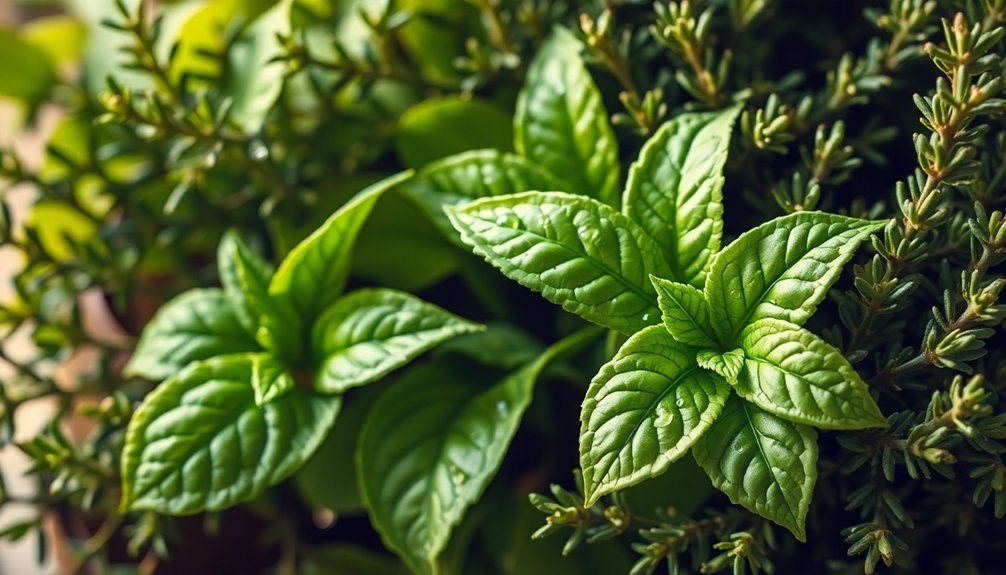
When exploring the world of herbal heart notes in perfumery, you'll discover their profound impact on your emotional and psychological well-being.
These aromatic compounds can considerably influence your mood, stress levels, and cognitive function. Lavender soothes your mind while rosemary enhances mental clarity, and thyme invigorates your senses.
- Herbal heart notes can reduce your anxiety levels and promote relaxation, with studies showing they trigger up to 75% of daily mood changes.
- You'll experience improved cognitive function and memory retention, especially when exposed to notes like rosemary.
- These scents create powerful emotional connections by evoking personal memories and fostering a sense of comfort.
Whether you're seeking stress relief or mental clarity, herbal heart notes offer a natural way to enhance your psychological well-being through aromatherapy.
Seasonal Applications of Herbal Heart Notes
The strategic application of herbal heart notes varies considerably across seasons, letting you create perfectly balanced fragrances throughout the year.
In spring, you'll find lavender and violet leaf offering new, calming qualities, while galbanum adds depth to floral compositions.
Summer calls for bright, invigorating notes like geranium, basil, and mint that create an energizing effect.
As autumn approaches, you can turn to earthier options like patchouli and sage, which provide warmth and complexity. These blend beautifully with spicier notes like cinnamon to capture fall's essence.
Winter fragrances benefit from warming herbs like clove and nutmeg, often paired with cedarwood for structure.
You'll also find that some versatile herbs, like lavender and rosemary, work well across multiple seasons when properly balanced with other notes.
Creating Signature Blends With Herbal Middle Notes
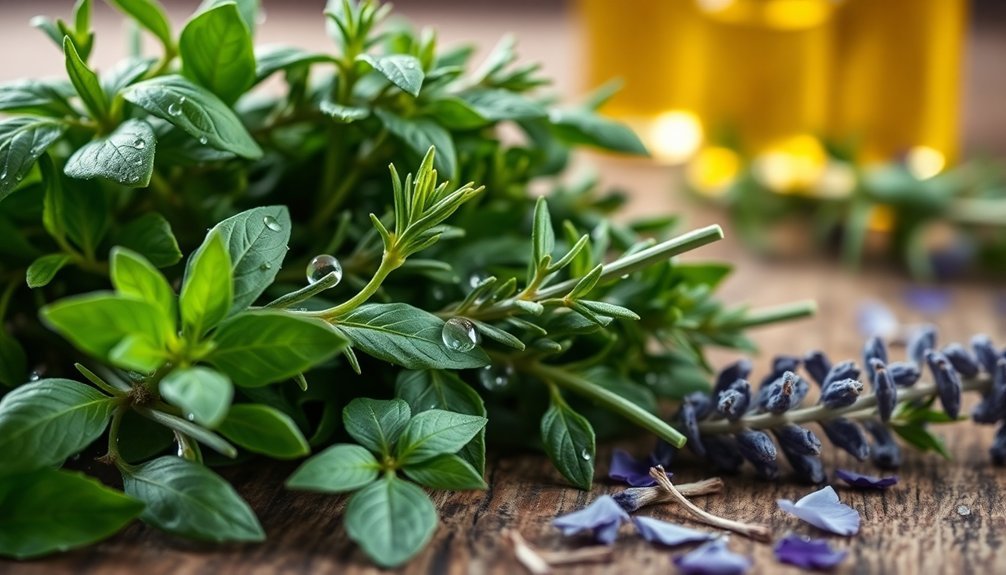
Creating your own signature fragrance with herbal middle notes requires a thoughtful balance of complementary scents and careful attention to proportions.
Start by selecting 2-3 herbal middle notes that make up 50% of your blend, such as lavender for relaxation, rosemary for clarity, or geranium for emotional balance.
- Combine floral accords like lavender and geranium for a harmonious heart note
- Test small amounts on your skin and observe how the scent develops over several hours
- Allow your blend to mature for at least 24 hours before making any adjustments
Remember to perform a patch test before applying your creation, and store your blend in a cool, dark place.
You'll know you've achieved the perfect balance when your middle notes create a cohesive scent that reflects your personal style while maintaining their therapeutic properties.
Frequently Asked Questions
How Long Do Herbal Heart Notes Typically Last on the Skin?
You'll notice herbal heart notes lasting 3-6 hours on your skin, emerging after top notes fade. They'll peak between 1-3 hours post-application, then gradually shift into base notes.
Can Herbal Heart Notes Cause Allergic Reactions in Sensitive Individuals?
Yes, you can experience allergic reactions to herbal heart notes, especially if you're sensitive. Common symptoms include skin irritation, dermatitis, and respiratory issues. It's best to patch test before using new fragrances.
Which Herbal Heart Notes Work Best in Hot, Humid Climates?
You'll find rosemary and thyme work exceptionally well in hot, humid climates due to their dehumidifying properties. Lavender, geranium, and clary sage also perform well, offering lasting freshness in sticky conditions.
Are Herbal Heart Notes More Prominent in Masculine or Feminine Fragrances?
You'll find herbal heart notes prominently used in both gender categories. While rosemary and thyme dominate masculine scents, feminine fragrances often feature geranium and clary sage. Lavender works beautifully across both styles.
Do Herbal Heart Notes Change Their Scent When Combined With Body Chemistry?
Yes, your body chemistry markedly affects how herbal heart notes smell on you. Your skin's pH, temperature, and natural oils can transform these notes, making them unique to your personal chemistry.
In Summary
Whether you're crafting your own scent or selecting a perfume, herbal heart notes offer endless creative possibilities. You'll find that lavender, sage, rosemary, thyme, and basil create distinctive middle notes that bridge the gap between top and base notes beautifully. Don't be afraid to experiment with both natural and synthetic versions – you can achieve remarkable results by balancing these herbaceous elements with floral, woody, or citrus accords.

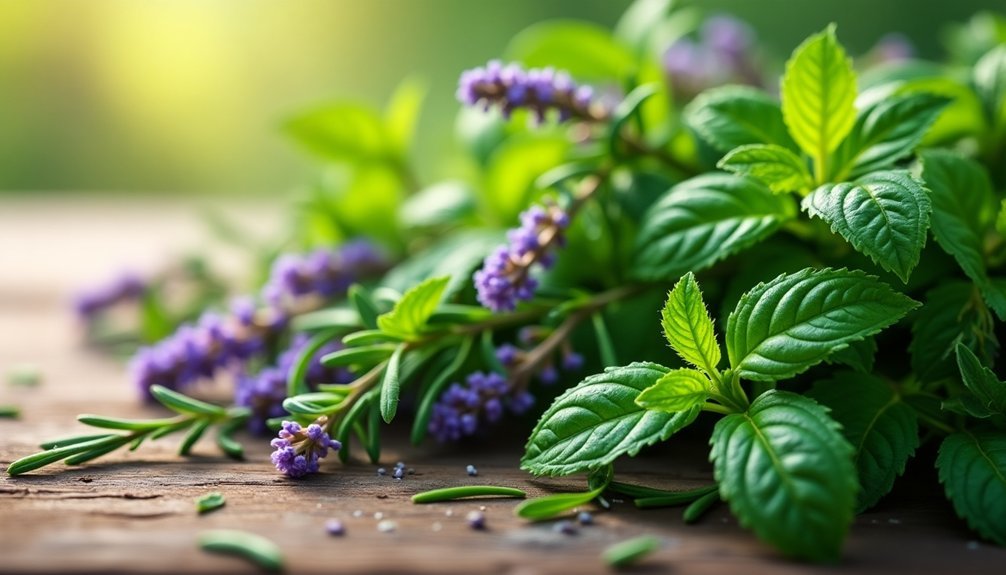



Leave a Reply